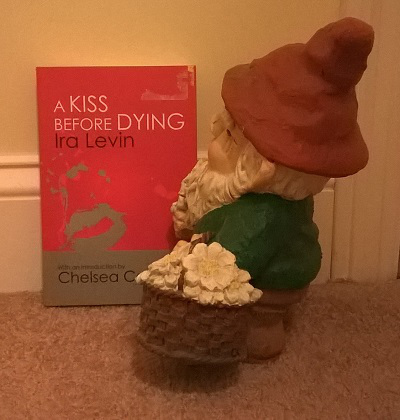
[Explanation of Reading Journal Entries/Ratings]
Post 1
[30] References:
“We’ve just got time for one more record, and it’s the late Buddy Clark singing ‘If This Isn’t Love.’ ”
(p.161)
Buddy Clark (1912 – 1949) was an American popular singer of the 1930s and 1940s. He became one of the nation’s top crooners before dying in a plane crash in 1949. His biggest hit was the song “Linda” (1946), written by Jack Lawrence for one-year-old Linda Eastman (later McCartney).
“If This Isn’t Love” is a popular 1946 song composed by Burton Lane with lyrics written by E. Y. Harburg. Buddy Clark recorded a version in November 1946.
[31]
He dropped the other two notebooks into the suitcase and turned around, his mouth opening to form Ellen’s name in a triumphant shout.
The shout didn’t come through. The exultant expression clung to his face a moment, like a stopped movie, and then it cracked and slid slowly away, like thick snow cracking and sliding from a canted roof.
(p.161 – 162)
[32]
Probably he’s all talked out after the – what’s the word? – logorrhea of a cocktail lounge. Good word.
“I bet you don’t know what logorrhea means,” he said.
(p.163)
[33] Levin’s writing feels fresh and wickedly funny in a very modern way; I can’t believe this was written over sixty years ago:
It annoyed him the way Mister Dwight Powell was standing there so blankly. Maybe he was too stupid to realize… “Maybe you don’t realize it, but this is a real gun, and it’s loaded.”
Powell didn’t say anything. He just went on looking at this gun, not even staring now – just looking at it with mildly distasteful interest, as though it were the first ladybug of the year.
“Look, I’m going to kill you.”
(p.163)
[34] I’m calling bullshit:
“Next thing the girl comes running upstairs – same prints on the door frame up there as on the cups and stuff in the kitchen.”
(p.173)
The Chief is telling Gant this within an hour (maybe two) of the police’s arrival at the murder scene. I don’t think they could have this kind of detailed fingerprint information so quickly.
[35]
There were moments of awkward hesitancy in his narration, as an on-leave soldier telling how he won his medals hesitates before describing to the gentle townsfolk how his bayonet ripped open an enemy’s stomach, then goes on and describes it because they asked how he won his medals, didn’t they? – describes it with irritation and mild contempt for the gentle townsfolk who never had to rip open anyone’s stomach.
(p.174 – 175)
[36]
She listened with the muzzle of his gun jabbing painfully into her hip; painfully only at first, then numbingly, as though that part of her were already dead, as though death came from the gun not in a swift bullet but in slow radiation from the point of contact.
(p.175)
[37] My only nit-pick of Levin’s writing in the whole book: He uses repetition in a scene – only one scene – which feels more like a mistake than a stylistic choice. At the very least, it stands out as an oddity for an author who is usually masterful at making his work invisible. When Levin’s on a roll, you never see his gears turning.
Ellen was huddled all the way over against the door, her body knotted tight, her eyes staring brokenly at the handkerchief-twisting hands in her lap (…)
She had cried; long throat-dragging animal moans; more sound and shaking than actual tears.
(p.174)
Her cries were long throat-dragging animal moans; more sound and shaking than actual tears.
And then she sat staring brokenly at the handkerchief-twisting hands in her lap.
(p.175)
[38] Reference:
Willard Herne, eleven, of nearby Randalia.
(p.179)
Randalia is a city in Fayette County, Iowa. The population was 68 at the 2010 census. (Can you call a place with a population of 68 a “city”?)
[39] References:
The reproduction of her favorite painting (Charles Demuth’s My Egypt; not quite realistic; its planes accentuated and enriched by the eye of the artist).
(p.188)
Charles Demuth (1883 – 1935) was an American watercolorist who turned to oils late in his career, developing a style of painting known as Precisionism.
His oil painting My Egypt, depicting a grain elevator in Lancaster, Pennsylvania, was finished in 1927. According to the Whitney Museum of American Art:
In Demuth’s image, the majestic grain elevator rises up as the pinnacle of American achievement – a modern day equivalent to the monuments of ancient Egypt.
[40] Reference:
The listen-in-the-dark themes of Grieg and Brahms and Rachmaninoff.
(p.188)
Edvard Grieg (1843 – 1907) was a Norwegian composer and pianist. He is widely considered one of the leading Romantic era composers.
[41]
On Saturdays she cleaned the rooms, and once each month she opened all the books to prevent their bindings from growing stiff.
(p.189)
[42]
And, like transient sparrows tolerated in an aviary, the pink rural faces gawking at the statue and the sun-sharpened spires of Saint Patrick’s across the street.
(p.192)
[43] Reference:
“Dinner at Antoine’s. Ellen wanted me to read it (…) Personally,” he said, “I go for books that have a little more meaning.”
(p.193)
Francis Parkinson Keyes (1885 – 1970) was an American author, and a convert to Roman Catholicism, whose works frequently features Catholic themes and beliefs. Dinner at Antoine’s (1947) was her biggest seller and one of only two mysteries she wrote.
[44] References:
The arched white smoothness of the Girl Washing Her Hair, the perfect spear of Bird in Space.
Two men were in the room that held the Lehmbruck sculptures.
(p.195)
Girl Washing Her Hair is a sculpture by American sculptor Hugo Robus (1885 – 1964). The original was finished in 1933.
Bird in Space is a series of sculptures by Romanian sculptor Constantin Brancusi (1876 – 1957). The original work was created in 1923.
It’s simple but strangely beautiful. According to the Met Museum:
[Brancusi] concentrated on the animals’ movement, rather than their physical attributes. In Bird in Space, the sculptor eliminated winds and feathers, elongated the swell of the body, and reduced the head and beak to a slanted oval plane.
Wilhelm Lehmbruck (1881 – 1919) was a German sculptor. His sculptures mostly concentrate on the human body and are influence by Naturalism and Expressionism. His works, including female nudes, are marked by a sense of melancholy and an elongation of form common to Gothic architecture.
[45] Reference:
They came to the Maillol woman, full-bodied, strident.
(p.197)
Aristide Maillol (1861 – 1944) was a French sculptor, painter, and printmaker. The subject of nearly all of Maillol’s mature work is the female body, treated with a classical emphasis on stable forms.
[46] Reference:
The blue and gold Aynsley saucer.
(p.199)
Aynsley China Ltd. is a British manufacturer of bone china tablewood, giftward and commemorative items. The company was founded in 1775 by John Aynsley in Land End, Longton, Staffordshire.
[47]
She watched her father’s expressionless face with waiting eyes, hoping that there would not be an argument because it would tarnish the entire evening, and hoping that there would be one because it would try the strength of what she felt for Bud.
(p.199)
[48] Reference:
Leo Kingship was waiting within the white door, sitting gingerly on a Louis Quinze sofa.
(p.203)
The Louis XV style or Louis Quinze was a French Rococo style in the decorative arts, and, to a lesser degree, architecture.
[49] Vocabulary:
Placing eighteen dollars on the waiter’s salver.
(p.205)
noun – a tray, typically one made of silver and used in formal circumstances.
[50] Reference:
They took a taxi to the theater where Saint Joan was playing (…) During the intermission, Marion was unusually voluble, her doelike eyes glittering brightly as she talked of Shaw and the acting.
(p.205)
Saint Joan is a play by George Bernard Shaw about 15th Century French military figure Joan of Arc. Premiering in 1923, three years after her canonization by the Roman Catholic Church, the play dramatizes what is known of her life based on the records of her trial.
In November of 1951, Bud and Marion could have seen Saint Joan at the Cort Theatre in New York. At that time, Uta Hagen (1919 – 2004) was playing the lead.
[51] Reference:
Marion came out of the kitchen with a raffia-covered bottle of Bardolino.
(p.207)
According to wine-searcher.com:
Bardolino is a light red wine made on the eastern shores of Lake Garda, in the Veneto region of north-eastern Italy.
[52] Reference:
“Dear lady, he was at lunch at twelve o’clock. It is now three o’clock. What is he, a rhinoceros?”
(p.210)
Do rhinos take an especially long time to eat?
From animals.mom.me:
The black rhino and the white rhino diets are very different. That’s partly because of the black rhino’s prehensile lip – basically a pointy lip that allows him to tear and pick up stuff easily (…) Because [white rhinos] don’t have a pointy lip to help them break twigs or dig for roots, the white rhino eats basically just short grass and some leaves. [White] rhinos are considered grazers, because they will eat constantly throughout the day.
[53]
Gant lit a cigarette. He sat silently for a moment, regarding it thoughtfully and working his lower lip with his teeth, as though awaiting a time signal. Then he began to speak in the easy, fluid, announcer’s voice.
(p.214)
[54]
Kingship’s face flickered with small uneasy movements, as though dust were blowing at it.
(p.222)
[55]
Marion said, “Are you jealous of Bud? Is that it? Because Ellen preferred him to you?”
“That’s right,” Gant said drily. “I’m consumed with jealousy.”
(p.223 – 224)
[56]
Kingship sighed. “Let me tell you something,” he said, not looking at Gant. “I had a wife and three daughters. Two daughters were taken from me. My wife I pushed away myself. Maybe I pushed one of the daughters too. So now I have only one daughter. I’m fifty-seven years old and I have one daughter and some men I play golf and talk business with. That’s all.”
(p.225)
[57]
He paused before each reply, examining his words before he spoke them, trying to determine what response they would bring, like a chess player touching pieces before making his move.
(p.230)
[58] Reference:
Propped on the sill within was an ice company sign, a square placard with 5, 10, 25, and X printed around the four sides. The X side was uppermost.
(p.235 – 236)
According to icetoolcollection.com:
Ice signs were displayed by the customer so the ice delivery man could see how much ice the customer wanted prior to departing his ice delivery wagon to deliver ice to the house. The sign would be positioned in the window to indicate how many pounds of ice the customer wanted. Most of the signs display quantities varying from 25 to 100 pounds.
I assume the 5, 10, 25 amounts were used for smaller homes, not businesses, and the “X” means, “I don’t need any ice today.”
[59]
“That – that son of a bitch-” Kingship spoke the phrase distinctly, as though not accustomed to using it.
(p.239)
[60] Reference:
“What is it they say? It’s as easy to fall in love with a rich girl as a poor.”
(p.245)
There is a saying: “It’s just as easy to fall in love with a rich man as a poor man,” but I can’t find the origins. According to barrypopik.com:
William Makepeace Thackeray (1811 – 1863) wrote in the novel The History of Pendennis (1848 – 1850): “Remember, it is as easy to marry a rich woman as a poor woman.” Thackeray – frequently anthologized for this remark – was not the first to come up with this saying.
[61] Reference:
What, never? No, never! What, never? Well – hardly ever! He turned and strode back to the hangar, humming Gilbert and Sullivan.
(p.251)
H.M.S. Pinafore: or, The Lass That Loved a Sailor is a comic opera in two acts, with music by Arthur Sullivan and a libretto by W.S. Gilbert. It opened in 1878. In the song “I am the Captain of the Pinafore” The Chorus and Captain exchange the lines:
CHORUS: What, never?
CAPTAIN: No, never!
CHORUS: What, never?
CAPTAIN: Hardly ever!
[62] Reference:
Over the soup he spoke of the copper shortage and disparaged the suggestions of the National Production Authority for its mitigation.
(p.256)
The National Production Authority (NPA) was an agency of the United States government which developed and promoted the production and supply of materials and facilities necessary for defense mobilization. It was part of the Department of Commerce. The agency was created in September 1950. It was abolished in October 1953.
Read A Kiss Before Dying if you like forensic shows, mysteries, clever plotting and clean writing.
I can’t remember the last time I was so tensely invested in a plot and I can’t believe that Levin was this good out of the gate. This will definitely rank high on my best of the year, if not reach the top.
This Friday, we’re cutting the love-fest short with a look at Being There.
Advertisements Share this:




